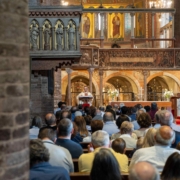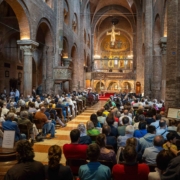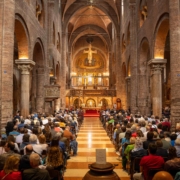Holy Mass XXV Dies Natalis Enzo Piccinini
Holy Mass on the occasion of the XXV Anniversary of the Dies Natalis of Enzo Piccinini celebrated by H.E. Msgr. Erio Castellucci, Archbishop Abbot of Modena-Nonantola and Bishop of Carpi, in the Cathedral of Modena
Sunday June 2, 2024
Homily by S.E. Mons. Erio Castellucci
Archbishop Abbot of Modena-Nonantola and Bishop of Carpi
“This is my blood of the covenant, shed for many.” It was actually a few hours before the shedding of blood, which was to occur the next day on the cross. Jesus anticipates it, symbolically, in the sign of the wine, thus giving new meaning to the Passover banquet where, in the story of the Last Supper, there is no longer a lamb, because the lamb is Him, Him in person, that expected, celebrated lamb, that lamb eaten now for more than twelve centuries by the Jews in remembrance of the liberation from Egypt.
That lamb is no longer represented by an animal, but by a person: the person of Jesus, with His blood shed for many. It strikes me that this blood is also shed for Judah. We have here in the pier just a representation of this scene from the Last Supper, where Jesus is just putting the bread in Judas’ mouth. This blood is also shed for him.
Jesus already knew that He would betray Him, because His blood is shed even for those who betray. And by His side is Peter, and Jesus already knew that He would deny Him, because He sheds His blood even for those who deny Him. And nearby are James, and John in the attitude of reclining His head on His chest. He is not yet the perfect disciple, either. Earlier he had argued with his brother and together they had asked Jesus if they could be placed one on the right and one on the left of Glory, angering the other ten. And there is also Thomas there-they are all identifiable because there are names next to the apostles, Thomas who a few days later would doubt, would not believe the testimony of the other ten who said, “We have seen the Lord.” “I want to see him too, his hands, his side.” He pours out the blood for him also, who doubts.
This blood is not poured out on selected people, it is not poured out on the best: this blood is poured out on the many, on the multitude, that is, on everyone. It is poured on those who betray, on those who deny, on those who fall prey to arrivisms, on those who doubt. This blood is poured out on everyone. For he who loves makes no selection of recipients. He who loves simply offers himself. He who loves sheds his blood, that is, he employs all his energies for the people he meets, for those for whom he is called to offer himself.
This shed blood: the only possible response is to shed our blood, that is, to respond with every fiber of our being to His offer. Unfortunately, Judas stands to demonstrate the extreme freedom of the Master toward the disciples, the dramatic freedom of the disciples toward the Master – every educational relationship is the meeting of two freedoms -.
Unfortunately, Judas decided to shed his blood not as an act of love, as a response to the Master’s act of love, but as an act of selfishness, of despair, in the persuasion that the Master’s love was inferior to his own sin. This is often the great sin: assuming that our mistakes cover God’s mercy. Despair is born. Judas sheds his own blood not as a response but as an act of extreme rebellion. But Peter, James, John, Thomas and all the others will respond with their blood, of martyrs or witnesses, to the end. This is the response to Jesus’ shedding of blood: the Lord asks that our response be to give life. Blood for the Jews is the seat of life. Blood for a Jew is what we Christians call soul, it is life flowing. To give blood first is not to die: it is to share one’s life with others, to make others live. In extreme circumstances, when it is required by the situation, it can also mean giving up one’s life: then it is shedding blood, as Jesus did. But always out of love, not out of fanaticism, not out of despair, not out of rebellion: always out of love.
Enzo was a sanguine person. Certainly he was a person who took Jesus’ offering of his own blood seriously and responded with his very strong character by giving his own blood, that is, literally expending himself, with impetus, with depth, with transport, sometimes with impulsiveness; always for the cause of Christ.
Each with his or her own character, sometimes milder, sometimes stronger, rougher, is called to respond to Christ because the real sin is precisely indifference, the real sin is that silence, that spiritual anemia that, before the Lord’s offer of life, responds with a yawn, with a weary assent, with a shrug of the shoulders.
We are all called to respond with our blood, that is, by giving our lives, by committing our passion, by involving our intelligence, our hearts, our affections in responding to Christ. The modalities change but the attitude is common: to Him who shed His blood for us, out of love, we respond by giving our lives every day, where we are, in the everyday, in everyday things, without necessarily heroic acts, required perhaps of some but not all. To give blood in the everyday, to love deeply where we are, with the passion of those who know that the Lord is second to none in offering Himself. May He who shed His blood for Judas, for Peter, for James, for John, for Thomas, for all others, help us never to be indifferent to His love, never to fade our hearts, never to fall into spiritual anemia.
May the Lord inspire us with the greatest grace toward people who, like Enzo, are called to transfuse their blood, to give in that body of Christ which is the Church, to give to others the passion to believe and adhere to Christ, when that passion becomes too tenuous. These are gifts from God-God’s gifts are always inconvenient, but they are genuine gifts.
Fondazione Enzo Piccinini












